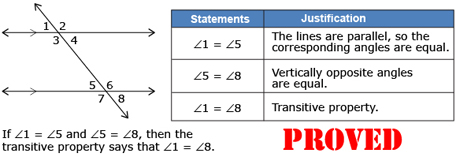Lesson 7
1. Lesson 7
1.6. Lesson 7 Summary
Module 2: Logic and Geometry
Lesson 7 Summary
Correctly applying the properties of angles formed by parallel lines and a transversal is important in many aspects of design. Architects, engineers, and designers use the properties of angles to plan their projects. They have to determine what properties are provable and then apply those to their designs.
In a proof, a specific conclusion is drawn through logical reasoning by starting with general assumptions that are known to be valid. This is known as deductive reasoning. These assumptions or statements that are accepted as true and used to prove a particular statement or conjecture are sometimes called theorems or properties.
The purpose of a proof is to show that the conjecture is true in all cases. The specific strategy that is used for a proof will vary based on the conjecture and the individual’s personal strategy for creating the proof. In this lesson you saw a variety of strategies that can be used to prove a conjecture about the angles formed when a transversal intersects a pair of parallel lines.
A useful first step is to make a sketch that illustrates the situation you are trying to prove. The sketch can help you develop a plan and identify the specific relationships or assumptions you need to include in your proof. Working backwards can help identify the relationships and their corresponding statements. Asking yourself questions such as “If the statement I want to prove is valid, what else would have to be valid in my diagram?” can help you to determine which relationships exist.

When deductive reasoning is used correctly in a proof, the conclusion drawn is valid. If any error occurs, the proof is invalid. Architects, engineers, and designers need to ensure that the reasoning behind their designs is not flawed. The success of the project and the reputation of the professional are both dependent on the proofs being valid.
In Lesson 8 you will use what you have learned about deductive reasoning to prove the properties of angles in a triangle.